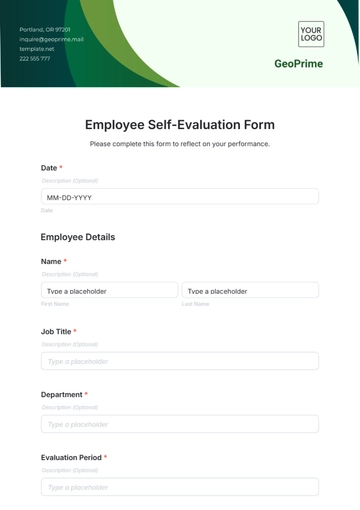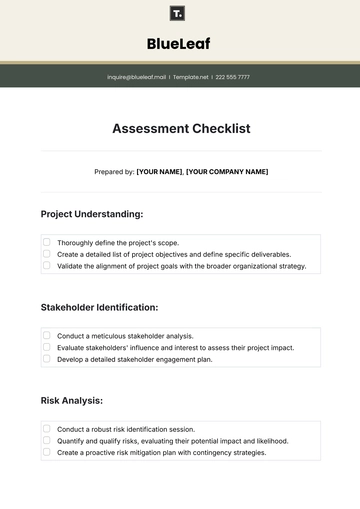Free Law Firm Risk Assessment Guide

I. Introduction
A. Purpose
The primary purpose of this Risk Assessment Guide is to establish a standardized approach to identifying, analyzing, and mitigating the various risks that we face in our legal practice. This guide aims to protect our firm's assets, reputation, and the interests of our clients by ensuring that potential threats are systematically and effectively managed. By adhering to these guidelines, we enhance our firm's ability to operate efficiently, maintain client trust, and comply with regulatory requirements.
B. Scope
This guide covers all aspects of risk relevant to our operations, spanning operational, financial, strategic, legal, and reputational risks. It is designed to be comprehensive, addressing risks that are both internal and external to our firm. The scope of this guide encompasses the activities of all members of our firm, from partners to administrative staff, ensuring that everyone is aware of and can contribute to our risk management efforts.
C. Responsibility
Responsibility for risk management lies with our Risk Management Committee, which is supported by various department heads and the senior management team. Specific responsibilities include:
Risk Management Committee: Oversees the development and implementation of risk management policies.
Department Heads: Ensure that their teams comply with risk management procedures.
Senior Management: Provides the resources and support necessary for effective risk management.
II. Risk Identification
A. Risk Categories
Managing risks effectively requires an understanding of the different categories of risk we may encounter:
Operational Risks: Pertaining to the day-to-day operations and can include process failures, human errors, and system breakdowns.
Financial Risks: Associated with the financial operations of the firm, including investments, cash flow management, and credit risks.
Strategic Risks: Related to changes in the legal market, client demands, and our strategic decisions.
Legal/Compliance Risks: Stem from potential violations of laws, regulations, or ethical standards.
Reputational Risks: Impact the trust and confidence that our clients and the public have in our firm.
B. Sources of Risk
Risks can arise from various sources, both within and outside our firm. Major sources include:
Internal | External |
|---|---|
Employee actions Internal processes Organizational structure | Regulatory changes |
C. Common Risks in Legal Practice
Our firm must be particularly vigilant about risks commonly faced in legal practice:
Data Breaches: Unauthorized access to confidential client information can result in legal and reputational damage.
Conflict of Interest: Situations where the firm's interests potentially conflict with those of our clients can undermine trust and lead to legal complications.
Regulatory Compliance: Failure to adhere to all applicable laws and regulations can result in fines, sanctions, and damage to our reputation.
Client Dependency: Overreliance on a limited number of clients can pose significant business risks if those relationships are jeopardized.
III. Risk Analysis
A. Assessing Probability
Assessing the probability of risks involves estimating the likelihood that a given risk will materialize. This assessment is critical to understanding which risks need immediate attention and which may be monitored over time. Guidelines for assessing probability include:
Historical Data: Review past incidents to identify trends and frequencies of similar events.
Industry Benchmarks: Compare with industry data to gauge common occurrences and their triggers.
Expert Judgment: Utilize the knowledge of experienced professionals within and outside the firm to predict risk likelihood.
B. Assessing Impact
Evaluating the impact of risks is essential to understanding the potential consequences on our firm’s operations and objectives. Impact assessment guidelines include:
Financial Costs: Estimate the potential financial loss resulting from the risk, including direct and indirect costs.
Operational Disruption: Assess how the risk could affect daily operations and the delivery of services to clients.
Reputational Damage: Consider the possible harm to our firm’s reputation and client relationships.
C. Risk Matrix
A risk matrix helps visualize and categorize risks based on their probability and impact, facilitating easier prioritization. Below is an example of a risk matrix used in our assessment process:
Risk | Probability | Impact |
|---|---|---|
Data Breaches | High | High |
Conflict of Interest | Medium | High |
Regulatory Compliance | Low | High |
Client Dependency | Medium | Medium |
IV. Risk Evaluation
A. Prioritizing Risks
Once risks are identified and analyzed, prioritizing them ensures that resources are allocated efficiently. Criteria for ranking risks include:
Impact on Strategic Goals: Risks that could derail our strategic objectives receive higher priority.
Regulatory Requirements: Compliance-related risks are prioritized to avoid legal penalties and sanctions.
Resource Availability: Availability of resources necessary to mitigate the risk also influences prioritization.
B. Risk Appetite
Our firm’s risk appetite—the level of risk we are willing to accept in pursuit of our strategic objectives—greatly influences how we prioritize risks. This section discusses our approach to risk tolerance:
Strategic Risks: We may accept higher risk levels here as these are often tied to growth and innovation.
Operational and Compliance Risks: We maintain a low tolerance for these risks due to their potential to disrupt business continuity and incur legal penalties.
Financial and Reputational Risks: Moderate risk appetite as these can affect firm stability and market position but are often manageable with effective controls.
V. Risk Mitigation Strategies
A. Preventive Measures
To proactively address risks before they become issues, we implement several preventive measures across our firm:
Regular Audits and Reviews: Conduct regular internal and external audits to ensure adherence to policies and to identify areas of risk early.
Staff Training: Provide ongoing training to all staff members on compliance, data security, and ethical conduct to prevent violations and breaches.
Policy Development and Updates: Continuously update our policies and procedures to reflect new laws, technologies, and best practices in risk management.
B. Corrective Actions
When risks materialize, having effective corrective actions in place is crucial to minimize impact and restore operations:
Incident Response Plans: Implement and regularly update incident response plans for different types of risks, such as data breaches or legal violations.
Performance Improvements: Address gaps in performance that may contribute to risks by adjusting processes or providing additional training.
Client Communication Protocols: Establish protocols for timely and transparent communication with clients when issues affecting them occur.
C. Risk Transfer
Some risks are best managed by transferring them to third parties:
Insurance: Purchase comprehensive insurance policies to cover potential liabilities, such as professional liability insurance, cyber insurance, and property insurance.
Contractual Transfers: Use contracts to shift certain risks to other parties, such as through indemnity clauses or limitations of liability.
VI. Training Program
A well-designed training program is vital for ensuring that our team is equipped to handle and mitigate risks effectively. The following table outlines our key training initiatives, their frequency, and duration:
Program | Frequency | Duration |
|---|---|---|
New Hire Risk Orientation | Upon hiring | 1 day |
Annual Compliance Training | Annually | 2 days |
Cybersecurity Best Practices | Biannually | 1 day |
Crisis Management Workshops | Annually | 1 day |
Legal Updates and Briefings | Quarterly | Half-day |
VII. Monitoring and Review
Regular monitoring and review are essential components of effective risk management. We conduct continuous monitoring through our internal control systems to detect any deviations from our risk thresholds and to assess the effectiveness of our risk mitigation strategies. Reviews are conducted semi-annually by the Risk Management Committee, which assesses the current risk landscape, evaluates the performance of risk management practices, and recommends updates as necessary. All findings and recommendations from these reviews are reported to senior management and, if required, to the firm’s board of directors. This ensures that all levels of our organization are informed and engaged in the risk management process.
VIII. Legal and Regulatory Compliance
Ensuring compliance with legal and regulatory standards is a cornerstone of our risk management strategy. To maintain compliance, we schedule regular audits both internally and with third-party auditors. These audits are conducted annually, with additional unscheduled audits triggered by significant legal updates or internal changes. Key U.S. laws and regulations that our firm adheres to include:
The Sarbanes-Oxley Act (SOX): Imposes strict auditing and financial regulations on corporations.
The Health Insurance Portability and Accountability Act (HIPAA): Ensures the protection of personal health information.
The Fair Labor Standards Act (FLSA): Governs employment law concerning minimum wage, overtime pay, and employment classification.
The Americans with Disabilities Act (ADA): Prohibits discrimination based on disability.
The Dodd-Frank Wall Street Reform and Consumer Protection Act: Regulates financial markets and protects consumers.
- 100% Customizable, free editor
- Access 1 Million+ Templates, photo’s & graphics
- Download or share as a template
- Click and replace photos, graphics, text, backgrounds
- Resize, crop, AI write & more
- Access advanced editor
Discover the Law Firm Risk Assessment Guide Template from Template.net, expertly designed to help you identify and mitigate potential risks. This template is fully editable and customizable in our AI Editor tool, ensuring you can adapt it precisely to your firm’s needs for robust risk management strategies.





























